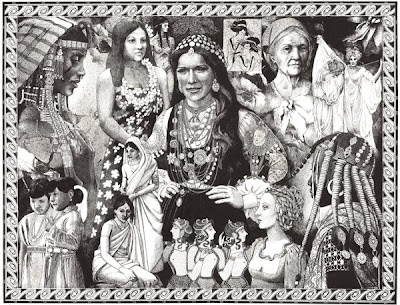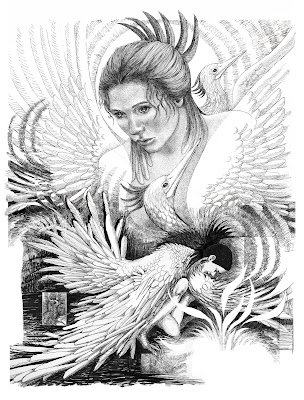 Daughters of the Earth. Pen and Ink.
Daughters of the Earth. Pen and Ink.LINE
Line is probably the most primitive method of creating shapes, maps, or writing. The mind recognizes the edges of shapes as they stand out against a background. Lines are formed by edges of things. As children we usually made a line indicate a shape or several shapes to make a human form, a house, the ground, a tree, and the sun, before filling in those shapes with color.
Line as a way of indicating a subject has evolved through the ages, so that lines and dots also form tones, shadows and suggest three dimensions even though we draw in two dimensions.
Line is probably the most primitive method of creating shapes, maps, or writing. The mind recognizes the edges of shapes as they stand out against a background. Lines are formed by edges of things. As children we usually made a line indicate a shape or several shapes to make a human form, a house, the ground, a tree, and the sun, before filling in those shapes with color.
Line as a way of indicating a subject has evolved through the ages, so that lines and dots also form tones, shadows and suggest three dimensions even though we draw in two dimensions.
 The Phoenix Always Rises. Pen and Ink
The Phoenix Always Rises. Pen and InkLine does not have to be limited to black on white. If you find line a natural way of expression for you, try using color. Try widening your lines. Draw in pastel, crayon, or the side of a 2 " square piece of mat board dipped in watercolor. Make lines and areas of color with the square of mat board. Think of using white on black or on a deep solid color.
Scratch board is a chalk coated board which if colored with inks can be scratched through, making white lines, looking like pen and ink in reverse.
Scratch board is a chalk coated board which if colored with inks can be scratched through, making white lines, looking like pen and ink in reverse.
When looking at objects in a painting or in real life, notice the contours and boundaries. These are lines which have direction and movement. Lines draw the eye in the direction they point toward. The goal of an artist is to keep the viewer's attention inside the picture plane long enough to see everything you placed there. Controlling the lines in your composition will help to do this. Lines with the most contrast are the most noticable.
Diagonal lines tend to create an illusion of depth, or perspective. Diagonal strokes behind a figure give the impression that the space behind the person or object is not flat, and when used on the the figure will imply the figure has dimension, as well.
There also needs to be a place where the eye may comfortably leave the frame if desired, or quiet places within the picture plane which create a sense of peace, or a welcome place of rest for the viewer.
Writing and Images in this blog are the property of Ruth Zachary.







